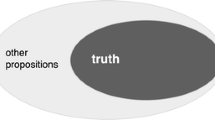Abstract
It has been argued that academic organizations are organized anarchies with ambiguous goal functions and uncertain technologies. Academia cannot evaluate itself because its dynamics is the “garbage-can” process. The counter-argument is that rational academic man(woman) is a substitute for organizational foolishness. The organizational behavior of academic institutions must be interpreted in terms of the logic of the academic profession.
Similar content being viewed by others
References
Altbach, P. (ed.) (1974). University Reform. Cambridge: Schenkman Publishing Company.
Altbach, P. (ed.) (1977). Comparative Perspectives on the Academic Profession. New York: Praeger.
Argyris, C. (1960). Understanding Organizational Behavior. Homewood, IL: Dorsey.
Axelsson, R. (1981). Rationell Administration. Stockholm: AEW Geber.
Becher, A. and Kogan, M. (1980). Structure and Process in Higher Education. London: Heineman.
Burns, T. and Stalker, G. M. (1961). The Management of Innovation. London: Tavistock.
Burns, T. (1963). “Industry in a new age,” in New Society, reprinted in D. S. Pugh (ed.), Organizational Theory. Harmondsworth: Penguin, 1971.
Clark, B. (1978). “Academic power: concepts, modes and perspectives,” in J. Van de Graff et al. (eds.), Academic Power: Patterns of Authority in Seven National Systems of Higher Education. New York: Praeger.
Clark, B. (1983). The Higher Education System. Academic Organization in Cross-National Perspective. Berkeley: University of California Press.
Converse, P. (1963). “The nature of belief systems in mass publics” in D. E. Apter Ideology and Discontent. New York: The Free Press.
Daalder, H. and Shils, E. E. (eds. (1982). Universities, Politicians & Bureaucrats: Europe and the United States. Cambridge: Cambridge University Press.
Enderud, H. G. (1973). Four Faces of Leadership in an Academic Organization. Copenhagen: Munhsgaard.
Fayol, H. (1949). General Industrial Management. London: Pitman.
Fayol, H. (1971). “General principles of management,” in D. S. Pugh (ed.), Organization Theory. Harmondsworth: Penguin.
Glenny, L. A. (ed.) (1979). Funding Higher Education: A Six-Nation Analysis. New York: Praeger.
Gouldner, A. (1957). “Cosmopolitans and locals - I,” Administrative Science Quarterly, vol. 2.
Gouldner, A. (1958). “Cosmopolitans and locals: towards an analysis of latent social roles - II,” Administrative Science Quarterly, vol. 2.
Halsey, A. H. and Trow, M. (1971). The British Academics. London: Faber.
Lane, J-E. and Frederiksson, B. (1983). Higher Education & Public Administration. Stockholm: Almquist & Wiksell International.
Lane, J-E. and Stenlund, H. (1983a). “Bureaucratization of a system of higher education,” Comparative Education 19(3): 305–323.
Lane, J-E. and Stenlund, H. (1983b). “The higher education profession in Sweden: structure, flexibility and equality,” European Journal of Education 18: 229–244.
Lane, J-E., Stenlund, H. and Westlund, A., (1982). “Variety of attitudes towards the comprehensive university,” Higher Education 11: 441–474.
Lane, J-E., Stenlund, H. and Westlund, A. (1981). “Is there a university crisis in Sweden,” European Journal of Education 16: 3–4.
Lawrence, P. R. and Lorsch, J. W. (1967). Organization and Environment: Managing Differentiation and Integration. Boston: Harvard University Press.
Likert, R. (1971) “The principle of supportive relationships” in D. S. Pugh (ed.), op. citNew York: McGraw-Hill.
Likert, R. (1961). New Patterns of Management. New York: McGraw-Hill.
March, J. and Olsen, J. P. (1976). Ambiguity in Organizations. Oslo: Universitetsforlaget.
Neave, G. (1976). Patterns of Equality: the Influence of New Structures in European Higher Education upon the Equality of Educational Opportunity. Windsor: NFER.
Parsons, T. (1951). The Social System. New York: The Free Press.
Parsons, T. (1964). Structure and Process in Modern Societies. Glencoe: The Free Press.
Parsons, T. and Platt, G. M. (1975). The American University. Cambridge: Harvard University Press.
Perkins, J. A. and Baird Israel, B. (1972). Higher Education: From Autonomy to Systems. New York: International Council for Educational Development.
Pesonen, P. (1982). “Finland - the ‘one man - one vote’ issue,” in H. Daalder and E. Shils (eds.), op. cit.Universities, Politicians & Bureaucrats: Europe and the United States. Cambridge: Cambridge University Press.
Pugh, D. S. (ed.) (1971). Organization Theory. Harmondsworth: Penguin.
Reichenbach, H. (1966). Elements of Symbolic Logic. New York: The Free Press.
Ruin, O. (1982). “Sweden: external control and internal participation: trends in Swedish higher education,” in H. Daalder and E. Shils (eds.), op. cit.Universities, Politicians & Bureaucrats: Europe and the United States. Cambridge: Cambridge University Press.
Thompson, J. D. (1967). Organizations in Action. New York: McGraw-Hill.
Trow, M. (1975a). “Public and private lives of higher education,” Daedalus II, winter.
Trow, M. (1975b). Teachers and Students. New York: McGraw-Hill.
Trow, M. (1984). “Leadership and organization: the case of biology at Berkeley” in R. Premfors (ed.), Higher Education Organization: Conditions for Policy Implementation. Stockholm: Almqvist & Wiksell International.
Wildavsky, A. (1979). “The self-evaluating organization,” in A. Wildavsky (ed.), Speaking Truth to Power. The Art and Craft of Policy Analysis. Boston: Little, Brown, pp. 212–237.
Author information
Authors and Affiliations
Rights and permissions
About this article
Cite this article
Lane, JE. Academic profession in academic organization. High Educ 14, 241–268 (1985). https://doi.org/10.1007/BF00136108
Issue Date:
DOI: https://doi.org/10.1007/BF00136108




